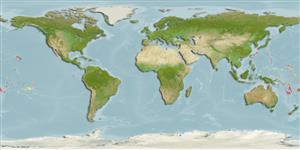Environment: milieu / climate zone / depth range / distribution range
Οικολογία
Θαλασσινό(ά); εύρος βάθους 0 - 2 m (Ref. 58302). Tropical; 28°N - 28°S
Pacific Ocean: Marshall Islands, Hawaii and Rapa.
Μέγεθος / Βάρος / Age
Maturity: Lm ? range ? - ? cm
Max length : 5.0 cm TL αρσενικό/απροσδιόριστο; (Ref. 9769)
Ραχιαίες άκανθες (συνολικά) : 5 - 7; Μαλακές ραχιαίες ακτίνες (συνολικά) : 14 - 16; Εδρικές άκανθες: 1; Μαλακές εδρικές ακτίνες: 20 - 25. Teeth in jaws restricted to first third along free edge of premaxilla. Dorsal edge of opercle without notch and process (Ref. 9769).
Inhabits rough surf and waves around rocky headlands and reefs. Nothing is known of the biology of this species (Ref. 9769).
Life cycle and mating behavior
Γεννητική Ωρίμανση | Αναπαραγωγή | Γεννοβολία | Αβγά | Γονιμότητα | Προνύμφες
Ivantsoff, W., 1999. Isonidae. Surf sardines. p. 2140-2143. In K.E. Carpenter and V.H. Niem (eds.) FAO species identification guide for fishery purposes. The living marine resources of the Western Central Pacific. Volume 4. Bony fishes part 2 (Mugilidae to Carangidae). FAO, Rome. (Ref. 9769)
IUCN Red List Status (Ref. 130435: Version 2024-1)
Threat to humans
Harmless
Human uses
αλιεία: χωρίς ενδιαφέρον
Εργαλεία
Special reports
Download XML
Διαδικτυακές πηγές
Estimates based on models
Preferred temperature (Ref.
123201): 25.1 - 29.5, mean 28.1 °C (based on 427 cells).
Phylogenetic diversity index (Ref.
82804): PD
50 = 0.5625 [Uniqueness, from 0.5 = low to 2.0 = high].
Bayesian length-weight: a=0.00389 (0.00180 - 0.00842), b=3.12 (2.94 - 3.30), in cm total length, based on all LWR estimates for this body shape (Ref.
93245).
Τροφικό Επίπεδο (Ref.
69278): 3.1 ±0.3 se; based on size and trophs of closest relatives
Fishing Vulnerability (Ref.
59153): Low vulnerability (10 of 100).
